As a kid growing up in the 1950s, Thanksgiving Day was always special. In addition to my mom’s great cooking, my dad and I would always watch the Green Bay Packers play the Detroit Lions on CBS. Thanksgiving 1959, however, was different: it was the first Thanksgiving since my dad had passed away in July of ’59, and there was another football game offered on TV—Carolina versus Duke on NBC. My dad, UNC Class of ’34, would have loved it. So today, fifty-eight years later, I would like to look back to Carolina’s 1959 season and a special Thanksgiving Day game. —Jack Hilliard, UNC Class of 1963
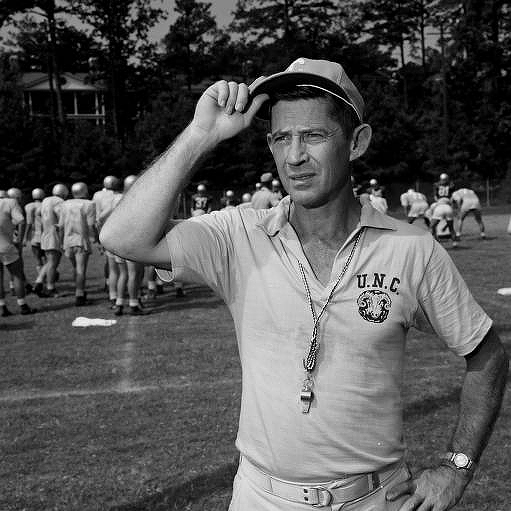
The telephone rang shortly before 11:00 p.m. in the control room at WFMY-TV in Greensboro on Thursday, July 23, 1959. It was UNC Athletic Director Chuck Erickson calling anchorman Charlie Harville. Harville rushed from the studio to take the call. Erickson related the sad news that UNC Head Football Coach Jim Tatum had died about fifteen minutes earlier. Harville got the details and ran back into the studio. No time to prepare a script, he gave an emotional report about the passing of his dear friend. The Tar Heel Nation was in shock. My dad passed away two days later, on July 25th.
The UNC Athletic Council took only four days to select Tatum’s successor. At 5:40 p.m. on July 27, 1959, Chancellor William B. Aycock with Athletic Director Charles (Chuck) Erickson at his side, made the announcement that Tatum assistant, 39-year-old James Benton Hickey would be the new Tar Heel coach with a three-year contract. He would become known as Jim Hickey. In accepting the position, Hickey told a large group of newsmen gathered at The Pines Restaurant in Chapel Hill, “I appreciate this opportunity. It is one I have always wanted. My only regret is the circumstances under which it had to come about.”
The 1959 UNC football season was fifty-three days away. The Tar Heels would face nine tough opponents, leading up the forty-sixth meeting between rival Duke for a regular season-ending matchup in Duke Stadium scheduled for Saturday, November 21st. On July 30th—three days after UNC’s coaching announcement—we got the news that NBC-TV had negotiated a $208,000 arrangement to play a national TV game on Thanksgiving Day, November 26th. The two schools had never played on Thanksgiving.
Carolina’s 1959 season officially got underway on Saturday, September 19th with a two-point home loss to Clemson 20-18. The following weekend came a second loss, this time to Notre Dame in South Bend 28-8. At this point, Coach Hickey decided to change his game plan. Up to this point he had followed the game strategy that Coach Tatum had put in place before his death. Hickey’s plan worked; two home-game-wins followed with victories over NC State 20-12 and South Carolina 19-6. A road game with Maryland was next. The Heels played well at College Park, but couldn’t contain Maryland’s “jack-rabbit-backs.” The final score: Terrapins 14, Tar Heels 7.
Starting the second half of the season, Carolina traveled to Winston-Salem for a game with Wake Forest on October 24th. UNC’s quarterback Jack Cummings was able to complete only two passes, but Carolina’s running game was enough for a 21-19 win. With four games remaining in the ’59 season, Carolina’s record was 3-3 on the year.
The next two games, at home against Tennessee and on the road at Miami, were disastrous for the Heels. Carolina scored a combined fourteen points against the two rivals in the two losses. Next, Virginia came to Chapel Hill for the 64th meeting between the Tar Heels and the Cavaliers on November 14th. On this day, Coach Hickey’s charges could do no wrong in handing Virginia its 17th consecutive defeat 41-0. With photographer Hugh Morton shooting from the sidelines, a small Kenan Stadium crowd of 21,000 saw Carolina set an ACC and Kenan Stadium record of 583 yards of offense. The win brought Carolina’s record to 4-5 on the season and set the stage for the annual game with Duke.
Duke and Carolina matched up well for their 46th meeting. Against mutual opponents, Carolina did better against South Carolina than did Duke, but the Blue Devils were stronger against Wake. Performances of both teams against State and Clemson were about the same. Both teams had records were 4-5, but Duke was made a 4-to-6-point favorite.
‘Twas the night before Thanksgiving and all through Duke Stadium, thirty technicians scurried like mice to get everything ready for the coast-to-coast telecast—fifteen from NBC and fifteen from AT&T made the deadline. All was ready to go by 8:00 p.m. on Thanksgiving Eve, eighteen hours before the scheduled 2:00 p.m. kickoff.
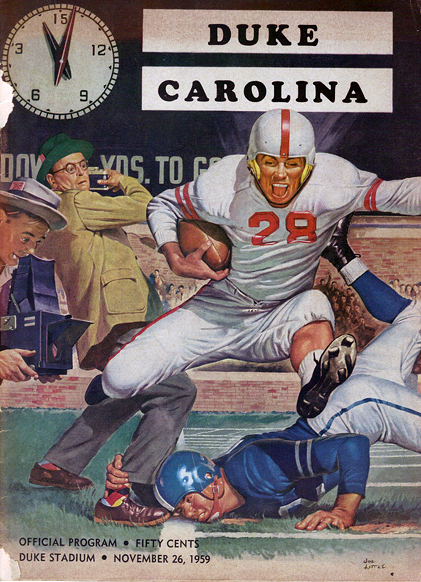
Thanksgiving Day 1959 dawned clear and mild. In the broadcast booth for the telecast were play-by-play announcer Lindsey Nelson and color commentator Red Grange. Since both Duke and Carolina students were on holiday, only 33,000 fans turned out for the game.
In his pregame locker room speech, Coach Hickey mentioned something for the first time during the ‘59 season. He said: “Boys, if there was ever a game Coach Tatum would have wanted you to win, this is it.”
Duke won referee John Donahue’s coin toss and elected to receive. The Tar Heels would kickoff and defend the south goal. On the first series, Duke failed to gain a first down and punted to the Carolina 44-yard line. Carolina moved down the field and scored with seven minutes left in the quarter. Duke, on its second series, fumbled and Carolina recovered at the Duke 22-yard line. Again, the Tar Heels couldn’t be stopped; they scored at the 4:55 mark and led 14-0 at the end of the first quarter.
Early in the second quarter, Duke got to the Carolina 11-yard line, but two dropped passes prevented a score. Carolina took over and marched to a third touchdown to lead 21- 0 at the 13:15 mark of the second quarter. There seemed to be a pattern forming: Duke couldn’t score and Carolina could. With 2:55 left in the second quarter the score was 28-0 and would remain so at halftime.
Duke’s Art Browning kicked off to start the second half. Tar Heel Don Klochak received the ball at the Carolina 7-yard line and he was off to the races for 93 yards. Carolina led 35-0 with 14:15 left in the third quarter. The trend continued: another Duke fumble led to another Carolina score at the 2:40 mark in the third making the score 42-0.
With 7:05 left in the game, Tar Heel George Knox, a fullback that Carolina’s Alumni Review called “fifth-string” raced 32-yards down the right sideline for Carolina’s final touchdown. With that TD, the score was 48-0, and Coach Hickey could hear the Tar Heel crowd chanting: “Hickey, go for fifty!” Coach got the message. Second string quarterback Ray Ferris ran off right tackle for the two points making the score 50-0. It was about two minutes later that Coach Hickey made his famous quote, when one of his players congratulated him on a win. Coach said, “It isn’t over yet, boys.”
With twenty seconds left in the game and Carolina’s fourth and fifth stringers at the Duke four, Coach Hickey called a timeout. He then sent his eleven seniors back on the field with strict instructions, “Do not score!” Quarterback Jack Cummings then took the snap, leaned into the line, went down easily, and the clock ran out.
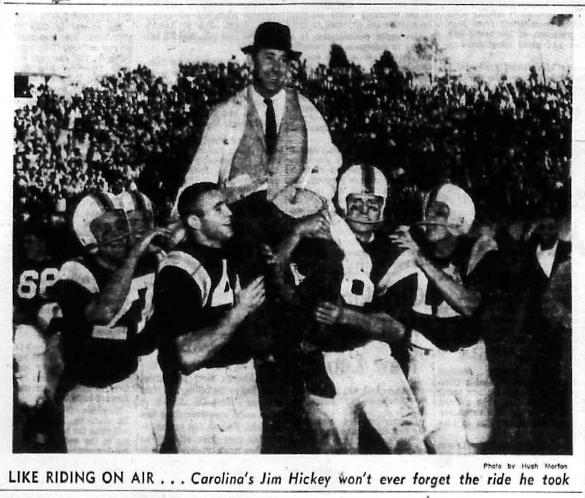
The Carolina players rode Coach Hickey on their shoulders to midfield. Photographer Hugh Morton’s shot of the scene in The Charlotte News (above) is classic. He had photographed a similar scene many times before with names like Justice, Snavely, and Morris. Now add Hickey to the list.
When the group arrived at midfield, Duke Head Coach Bill Murray was not in a friendly mood. “You really wanted that last touchdown bad, didn’t you,” Murray snapped, “putting that first bunch back in there.”
“Coach, you’ve got it all wrong,” said Hickey. “I sent my seniors back in there and told them not to score. . . . I just wanted the seniors to finish their careers on the field.” The two coaches then shook hands, and Murray turned and walked off the field. He would later phone Coach Hickey and congratulated him on the win.
A game with a win like this prompted tons of ink and airtime. The headline in The Daily Tar Heel on December 1st, when the Thanksgiving break was over and the DTH presses began rolling again, said it all in a huge above-the-heading headline: “50–0.”
As is always the case, the Duke–Carolina game brings out special guests, and the ’59 game was no exception. Peahead Walker, Red O’Quinn and NCAA District 3 Director Jim Corbett were there, among others. Sis Barrier, wife of Greensboro Daily News Executive Sports Editor Smith Barrier, in a society-type column about the game said, “Hugh Morton, who drove up from Wilmington with two of the boys—and left Julia at home by the TV set, was as happy as anybody.”
About fifteen minutes after the game ended, Coach Hickey was doing his post-game press conference when he was interrupted by a man wearing a Jim Tatum-type hat. There were tears in his eyes as he said: “I just had to come down and congratulate you, Coach Hickey, for this wonderful victory. I’m getting tired of all the criticism of you and this should silence them. And I appreciate it more than you know, for I’m sure this one was won for Jim.”
The man, who then silently made his way back into the crowd, was Dick Tatum of McColl, South Carolina, big brother of the beloved Carolina coach. Hickey then added: “Yes, I think you can say they won it for Coach Tatum, and why not? He’s the greatest guy I ever worked for.”
Category: Sports
JDF Rides the “Choo Choo”
Diabetes Month is observed every November so individuals, health care professionals, organizations, and communities across the country can bring attention to diabetes and its impact on millions of Americans. A View to Hugh would like to relate an event from the past that raised about $20,000 for diabetes research while at the same time had some fun at the expense of a Tar Heel sports legend. But first, a bit of history . . .
In 1970 a group of parents in New York City whose children had Type 1 diabetes founded an organization they called the Juvenile Diabetes Foundation, or JDF. The group was defined by its commitment to research-funding and finding a cure for juvenile diabetes. In 2012, the Foundation changed its name to the Juvenile Diabetes Research Foundation, or JDRF, putting a greater emphasis on the need for research.
No one in the celebrity world came close to doing what actress Mary Tyler Moore accomplished with JDRF. Her efforts were tireless. She had but one goal when it came to diabetes: to bring to the attention of the world the battle of diabetes and how important it is to one day cure it. She attended events, met with elected officials, testified before congress, and was always available to help local JDRF chapters with local fund raising by offering her celebrity. And that’s exactly how she helped the Charlotte chapter of JDF in 1984 when they staged their fifth annual JDF celebrity roast. Moore recorded videotape spots for the local television stations to air promoting the importance of supporting the Foundation.
Mary Tyler Moore died at the age of 80 earlier this year on January 25, 2017, but she will always be remembered in Charlotte for what she did to make the JDF Celebrity Roast of Tar Heel football legend Charlie “Choo Choo” Justice a success thirty-three years ago. Morton collection volunteer Jack Hilliard looks back to Monday, April 30, 1984.

A Prolog
A celebrity roast is an event in which a specific individual, a guest of honor, is subjected to good-natured jokes at their expense and it is intended to amuse the event’s audience and in many cases to raise money for a particular charity. Such events are intended to honor the individual in a unique way. In addition to jokes, such events may also involve genuine praise and tributes. The individual is surrounded by friends, fans, and well-wishers, who can receive some of the same good natured treatment as well during the course of the evening.
♦ ♦ ♦
Charles Justice has contributed his fame to hundreds of drives and worthy causes and has generally and consistently served as a wholesome example to impressionable youth.
—Hugh Morton, May, 2000
In early January 1984, it had been almost thirty years since Charlie Justice played his final football game with the Washington Redskins and almost thirty-four since he played his final varsity game with the Tar Heels. Nonetheless, when the Charlotte Chapter of the Juvenile Diabetes Foundation approached him about being the honored guest at the Fifth Annual JDF Celebrity Roast, Charlie’s reply was yes, “these things are for a great cause and I enjoy them.” Charlie had been guest of honor for two other celebrity gatherings, one in Greensboro on October 29, 1980 called “Dinner of Champions,” sponsored by the Central North Carolina Chapter of the Multiple Sclerosis Society, and one in his native Asheville on January 27, 1984 sponsored by the Western Carolina Children’s Foundation.
Justice was in great company at the fifth annual event. The four who preceded Justice were Clyde McLean of WBTV in 1979, Kays Gary of The Charlotte Observer in 1980, Eddie Knox, former Charlotte mayor in 1982, and famed basketball player and coach Horace “Bones” McKinney in 1983.
If you didn’t know better, you might think this was a UNC reunion. The event’s Honorary Chairman was Johnny Harris, UNC Class of 1969. Two other Tar Heels who worked behind the scenes were Erskine Bowles ’67 and Ray Farris ’62. Tar Heel roasters included newspaper publisher Orville Campbell ’42; Woody Durham, Voice of the Tar Heels, ’63; UNC President Dr. William Friday, ’48; and UNC All-America football star and Justice’s classmate Art Weiner, ’50.

With Master of Ceremonies Bill Hensley in control (sort of), the “roasting” fun began. Charlie was ushered into the Sheraton Center with the singing of “All The Way Choo Choo” to the delight of the 450 guests. The singing was led by Charlie’s daughter Barbara Crews.
Roaster: Orville Campbell
Chapel Hill newspaper publisher and the man responsible for recording “All The Way Choo Choo,” Orville Campbell then stepped up to the mic. “We always liked to take our songs over to Mr. W. D. Carmichael, then acting University President, and get his opinion. So when Hank Beebe and I finished All The Way Choo Choo, I went over to Carmichael’s office. He was extremely busy that day, but I went in anyway. His desk was covered with papers and he didn’t even look up.
“What do you want, Orville?” said Carmichael.
“I just wanted to know if you had heard our last song.”
“I hope the h— I have,” was Carmichael’s reply.
“Back in 1958,” Campbell continued, “I published a book which was written by Bob Quincy and Julian Scheer called Choo Choo: The Charlie Justice Story. We still have a warehouse full of those books over in Chapel Hill and I brought a few of them over here tonight to see if anybody here would pay $25 for a copy and if so, we’ll donate that money to JDF. And after we’re finished here, we’ll lock the door so Charlie can’t get away and have him sign ‘em.”
Campbell, who had been Charlie’s friend and fan since he arrived in Chapel Hill in 1946, then took out a letter that UNC Head Football Coach Carl Snavely supposedly wrote to Justice following that famous 1948 Texas game in Chapel Hill.
“In discussing your touchdown pass to Art Weiner, Charlie, Coach Snavely reminded you that, ‘Your wobbly pass to Art Weiner would have never been caught except that Art made a great catch and Texas had a poor pass defense.’”
Campbell then put on a number 22 college all-star jersey and modeled it for the crowd. Justice had donated the jersey to be auctioned with money going to JDF. The jersey went for $1,000.
Roaster: Woody Durham
Next up was “The Voice” of Tar Heel football and basketball, Woody Durham. Woody told the story of how Justice had decided to go to the University of South Carolina, when his brother Jack talked him out of it and convinced him he should go to UNC. Durham then turned to Charlotte JDF Chapter President Cassie Phillipi and asked, “Cassie, how much money do you think we could raise if we were holding this gathering in Columbia tonight?” Then Durham said he wanted to relate a recent story from his visit to Atlanta and added, “This is the only story I’ll tell from that Atlanta trip . . . I promise.”
“I was in Atlanta covering Dean Smith’s 1984 Tar Heels in the NCAA Tournament. The morning of the game, I was in the hotel room preparing for that night’s radio broadcast. The TV set was on but the sound was turned down real low and I wasn’t paying any attention to it. Then something caught my attention. The CBS program The Price is Right host Bob Barker had introduced a contestant form North Carolina. Then Barker said, ‘Who was the great All America football player from North Carolina back in the 1940s?’ Immediately someone in the audience shouted out, “Choo Choo.” Barker quickly added, That’s right, Choo Choo Charlie Justice.’”
“Folks it’s been 35 years since Charlie played for Carolina, but his name is still magic.”
Roaster: Bill Friday
Up next . . . University of North Carolina President Dr. William Friday spoke of “the rightness of all he symbolizes in American Sports.”
“When thirty years pass, a haze often settles over memory but not the recollections of Charlie Justice on the football field. He could do it all and he did. . . . All of the adulations and publicity never increased his hat size. An unassuming and cheerful manner always has characterized this man of extraordinary gifts. He has been greatly blessed in another way, he has Sarah.”

The 52-page souvenir program book for the 5th Annual JDF Roast is, in reality, a Charlie Justice scrapbook with dozens of Hugh Morton photographs included. The book was designed by George Van Allen of G.V.A. Associates and the Justice cover-caricature was done by Gene Payne of The Charlotte Observer. Charlie must have approved of the caricature; there was a huge version of it on the wall of his Cherryville office. Also included in the book is a beautifully written Justice profile by Observer columnist Ron Green.
Roaster: John Fraley
John L. “Buck” Fraley, President and Chief Operating Officer of Carolina Freight, was next up. Fraley’s company was a prime client of the Justice-Crews Insurance Company in Cherryville and had been so for many years. Fraley, a NC State graduate, talked about Charlie’s brief 1964 venture into politics. Also in the audience was Ken Younger who would take Fraley’s place with the company in 1985 following Fraley’s retirement. And if memory serves me correctly, it was Younger who bought the Justice All-Star jersey and then presented it to Charlie’s daughter Barbara. And by the way, Ken Younger, is a 1949 Duke graduate, who played football against Charlie and the Tar Heels.
Roaster: Art Weiner
Hugh Morton and the Charlotte JDF Chapter had prepared several large Charlie Justice action pictures and offered them for sale—the profits, of course, going to the Diabetes Foundation. So when Justice’s friend, teammate, and business partner Art Weiner stepped up to speak, he commented on the pictures.
“Did you ever wonder why there are so many fantastic Hugh Morton action pictures of Charlie Justice? Well, Hugh Morton was a world class, fantastic photographer, but there is another reason. We had one member on our team who never touched the ball . . . never made a tackle . . . never threw a block. His only purpose in life was to let Charlie Justice know where Hugh Morton was on the sidelines.”
“Where do you suppose he had his first heart attack? At halftime at the Carolina-Pitt game a few years back. They were carrying him out on a stretcher and everybody was looking and there was Charlie, waving to the crowd.”
Weiner then looked over at Orville Campbell. “I didn’t know the ball was supposed to spiral until I got into pro ball. Charlie always threw it end-over-end.”
“I lived beside Charlie for four years and he got new Cadilacs all four years. There was always trucks backing up to his door and unloading things.”
“My scholarship was a piece of wood with a nail on it, and I was told that I could keep anything that blew across my yard.”
When the laughter died down, Weiner got serious.
“I can honestly say Charlie Justice is not only the best friend I ever had, but in my opinion he is greatest athlete North Carolina ever had.”
Charlie Justice
When Justice finally got to the mic, he denied all, then thanked all for attending, and poked a little bit of fun at his “roasters,” telling his dear friend Art Weiner, “at least you had a scholarship at Carolina. . . I didn’t even have a one. . . Sarah had the scholarship in our family. And as for those four Cadilacs you mentioned . . . was really one ’48 Chevy.” He then related the importance of the fund-raising for diabetes research. At the end of the evening’s festivities, more than $20,000 had been raised for that research.
♦ ♦ ♦
Ron Green, writing in the May 2, 1984 edition of The Charlotte Observer under the headline “Highest Praise To Choo Choo,” said, “They came not to praise Charlie Choo Choo Justice but to roast him. They did both Monday night at the Sheraton Center. . . Others of his era are yellowed memories now, but Justice shines on, brightly, like a star . . . the long, rambling touchdown runs . . . the winning passes . . . the record-setting punts that took North Carolina out of danger. Almost campy. Almost as if he were playing himself in the lead role of a low budget movie with the title ‘Justice Rides Again.’ So good. So right.”
♦ ♦ ♦
WFMY-TV in Greensboro recorded the JDF roast in Charlotte on videotape for filmmaker David Solomon, the President of David Solomon Productions in Winston-Salem. Portions of the roast appear in Solomon’s Sports Extra TV production of All The Way Choo Choo. I had the honor of directing and editing the program, along with Larry Fitzgerald, the late WFMY-TV photojournalist. North Carolina Sports Hall of Fame Broadcaster Charlie Harville narrated the program. And once again, Charlie Justice’s popularity across the entire state was shown when the TV documentary was sponsored by “Goody’s” of Winston-Salem. The President of Goody’s, Duke University Class of 1949 football player Tom Chambers, was an opponent of Justice’s during their college days. In addition to the “Goody’s” commercials, the program also included JDF-Mary Tyler Moore public service announcements.
♦ ♦ ♦
In closing, I would like to revisit words from Bill Friday:
“(Charlie Justice) is loyal. He has been on call when his alma mater needed him. He has lent his name in time and talent to a host of worthy causes since his jersey went into the trophy case.”
“He has shown in his personal life the same quality of courage and determination he exhibited in athletics. Charlie Justice was voted All-American for his exploits on those memorable Saturdays of another era.”
“I want to say, Charlie, that in the eyes of your legions of friends today, you are an All-American every day of the week.”
The Heels vs. The Irish: A dominating past
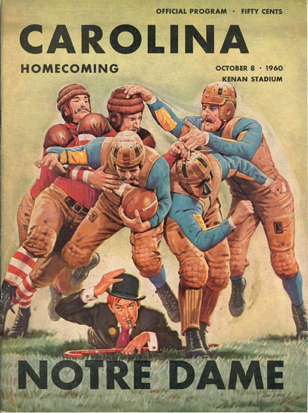
On Saturday, October 7, 2017, a very special event will take place in UNC’s Kenan Memorial Stadium. The Tar Heels will meet the Fighting Irish of Notre Dame. The game will mark the seventh meeting between the two in Kenan and the twentieth meeting overall. While the Irish have dominated the series, a Carolina–Notre Dame game will always be something special. Morton collection volunteer/contributor Jack Hilliard takes a look at some storied past meetings between these two great universities.
The love that people have for Notre Dame can’t be explained.
—Lou Holtz, Notre Dame head football coach 1986- 1996.
Growing up in North Carolina during the late 1940s and early 1950s, football Saturdays were special. There was Duke and State and Wake and Carolina, and we followed their every game. But there was always news in the papers and on the radio about Notre Dame; they seemed to always be a step ahead of our “Big Four.” Maybe it was because they seemed to always win. (Following a loss on December 1, 1945 to Great Lakes Navy, the Fighting Irish didn’t lose again until Purdue beat them on October 7, 1950.)
So it’s easy to imagine our excitement when we heard that Notre Dame would play Carolina on November 12th, 1949 in New York’s Yankee Stadium. In three previous blog posts, we have recounted that game on A View to Hugh and sister blog North Carolina Miscellany:
In those posts we noted Hugh Morton’s classic images from that day, even though it turned out to be the worst loss the Tar Heels would suffer during the “Charlie Justice Era.” The reason for the disaster was likely that Justice wasn’t able to play due to an injury he suffered the week before the big game in the Big Apple. But even without Justice, the game was special. The Daily Tar Heel published two air editions and flew them to New York. The headline in that first edition will always be remembered by Tar Heels who made the trip:
“Notre Dame And N.C. Tied 6-6 At Half.”
The second meeting between the two came less than a year later on September 30, 1950. . . . this time in South Bend, Indiana. This game will forever be remembered, not for Notre Dame’s 14 to 7 win, but the fact that it was the first live network television program of any kind ever transmitted into North Carolina. The ’49 game in NYC had been televised, but the signal did not reach North Carolina. But on this day, WBTV in Charlotte and WFMY-TV in Greensboro carried the game live across the Tar Heel state via the Dumont Television Network. The Greensboro Daily News reported that the estimated viewership in North Carolina was 200,000—nationwide it was 35 million.
Hugh Morton didn’t make the trip to South Bend in 1950, but was on hand back in Chapel Hill when the Irish made their first trip to Kenan on November 17, 1951. Editor’s note: most of Hugh Morton’s football negatives from the 1950s and 1960s are not identified, but Morton’s game credential survives. As negatives are identified in the future, we will add a selection of them to this post.
Carolina Sports Information Director Jake Wade, writing in the ’51 game day program called Notre Dame “the mighty and fabulous men from Indiana.” A full house of 44,500 football fans sat in cold, clear weather “amid Chapel Hill’s wonderland of fall colors,” as The Alumni Review reported. Those fans saw the Tar Heels put on a fourth quarter drive which fell three yards short of victory. Connie Gravitt’s fourth down pass into the end zone was batted down by Notre Dame’s Gene Carrabine, preserving the 12-to-7 Irish victory.
On October 25, 1952 head coach Carl Snavely and his Tar Heels returned to Notre Dame Stadium for the fourth meeting between the Heels and the Irish. 54,338 fans (most of them dressed in green and gold) saw a 7-to-7 tie at the end of the first quarter, but the Heels eventual fell 34 to 14.
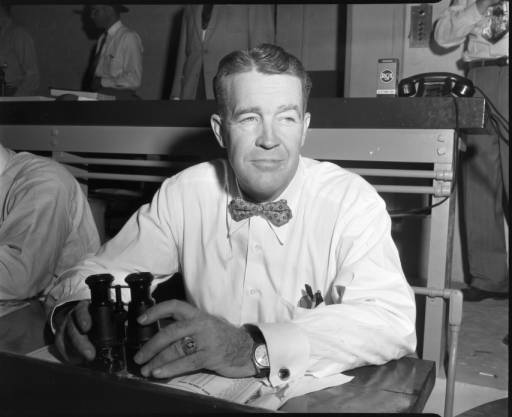
When Notre Dame returned to Chapel Hill on November 14, 1953 for its second visit, Carl Snavely had moved on and the Heels were coached by George Barclay. When this one ended, that familiar 34-to-14 score appeared on the scoreboard. The 1953 game would be Notre Dame’s College Football Hall of Fame coach Frank Leahy’s fifth and final win against the Tar Heels. At this point in the series, the two teams had met on five occasions with the Irish winning all five. Two games in Chapel Hill, two games in South Bend, and one in New York—with a total audience of 265,000.
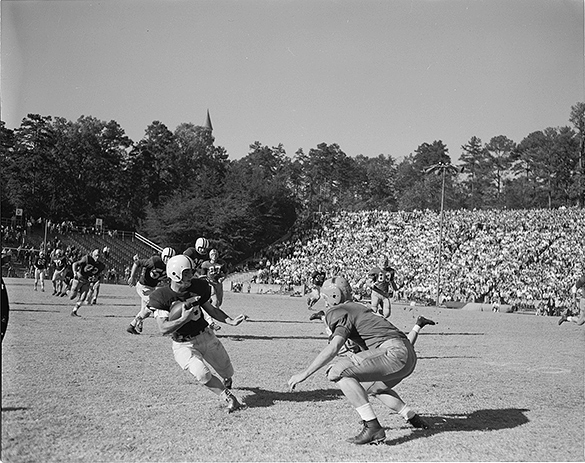
The week before the 1954 game, Notre Dame was made a 26-point favorite and when it ended they had a 29-point victory, 42 to 13. The game on November 12, 1955 in Kenan Stadium is often compared to that first meeting between the Heels and the Irish played in New York. The ’55 game was tied at half 7 to 7, but Notre Dame dominated the second half to win the game 27 to 7. Seated among the 33,000 in Kenan that afternoon was Tar Heel football legend Charlie Justice with his son Ronnie, and on the sideline in his usual spot was photographer Hugh Morton.
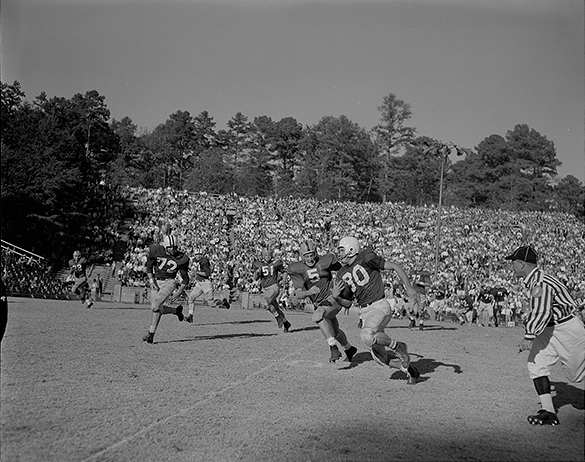
The game on November 17, 1956 back in South Bend marked the end of the first series of contracted games between Carolina and Notre Dame, and the first game under new Tar Heel head coach Jim Tatum. 56,793 fans saw a thriller as the game was tied with seventy-seven seconds to play, but Notre Dame took the lead as 1956 Heisman Trophy winner Paul Hornung scored the winning touchdown. Notre Dame’s eighth win made the series look like an all-Irish sweepstakes with an aggregate attendance of more than 410,000.
In 1958, the series returned with two more games in South Bend and two more Irish wins: 34 to 24 in ’58 and 28 to 8 in ’59. In that game on September 26, 1959, Nortre Dame held Carolina, under new head coach Jim Hickey, scoreless for three quarters.
Coming into Chapel Hill on October 8, 1960, Notre Dame had won all ten of the previous meetings, but on this day things were about to change. Homecoming in Chapel Hill is always fun, but on this day it was more fun than usual, as coed Jane Allen from Lambert, Mississippi was crowned Homecoming Queen, to the delight of 41,000 fans, mostly Tar Heels. The cheering crowd saw Carolina lead Notre Dame 12 to 0 well into the fourth quarter, thanks to the efforts of junior-quarterback Ray Ferris, who completed 6 passes for 115 yards and a first quarter TD pass to Skip Clement. Notre Dame completed 8 passes of 32 attempts and the Heels interested 5 of them. With the score 12 to 7, the final gun sounded and coach Jim Hickey got a ride on the shoulders of his team to midfield for a handshake with Notre Dame head coach Joe Kuharich.
In his post game interview, coach Hickey was asked how it felt to be the only UNC head coach to beat a Notre Dame team. “It would feel good to beat them anytime, anywhere,” Hickey said with a wide grin.
Fifteen seasons would pass before Notre Dame returned to Chapel Hill. During that span the two teams would meet four times in South Bend, ’62, ’65, ’66, and ’71—and Carolina would have only seven points to show for all four efforts: a 21-to-7 loss on November 17, 1962, while Notre Dame tallied three straight shutouts in ’65, ’66, and ’71.
Notre Dame’s return to Chapel Hill on October 11, 1975 proved to be one of the most exciting games of the series. After a scoreless first half, the Tar Heels took the lead at the 10:03 mark of the third quarter on Mike Voight’s 12-yard run. On their next possession, Quarterback Billy Paschall hit Mel Collins with a 39-yard touchdown pass to make the lead 14 to 0, and that lead continued well into the final quarter. With six minutes left in the game, Notre Dame head coach Dan Devine called on his second string quarterback . . . a fellow named Joe Montana, who led the Irish on two quick scoring drives to tie the score at fourteen. Then with less than two minutes to play, Carolina had an opportunity to take the lead, but missed its third field goal of the day and the Irish took over at their own 20 yard line. On second down, Montana hit Tom Burgmeier on a spectacular 80-yard scoring play that spelled defeat for the Tar Heels.
In the Carolina locker room following the game, UNC head coach Bill Dooley said, “To have a team like Notre Dame down 14 to 0 in the fourth quarter and then lose is really tough.” Notre Dame coach Dan Devine called it his “best win ever.”
During the 1975 season, the Tar Heel Sports Network invited former players to be game analysts to assist play-by-play Hall of Fame broadcaster Woody Durham. For the ’75 Notre Dame game the guest was UNC All-America end Art Weiner, who played a key role in the first meeting between the Heels and the Irish back in 1949.
Thirty-one years would pass before Carolina and Notre Dame would meet again. On November 4, 2006 it was yet another blowout Irish victory, this time, 45 to 26. Two years later, Notre Dame would make its most recent visit to Kenan on October 11, 2008. Carolina’s 29-to-24 win has one of those dreaded asterisks in the record book. An NCAA ruling in 2011 vacated that win. Six years later to the day, on October 11, 2014, Carolina made its most recent visit to South Bend. Alas, the Heels came away with yet another loss, this time 50 to 43 in a game that set a total points record for the series.
So, on Saturday, October 7th, head coach Larry Fedora’s Tar Heels will try once again to take down the Fighting Irish, but win or lose, there will be a certain excitement in the air in Kenan Memorial Stadium. Saturday’s game will also be featured on ABC/ESPN, with the opening kickoff scheduled for 3:30. After the game it will be five more years until Carolina and Notre Dame are next scheduled to play in South Bend in 2021, with a return match in Chapel Hill in 2022.
A Benny Goodman mystery . . . that leads to two more Morton mysteries
The post “A Benny Goodman Score” on June 3, 2017 brought back some fond memories for our volunteer contributor Jack Hilliard. As we prepare for tomorrow’s annual Carolina–Duke game, Jack shares a childhood memory of a Benny Goodman mystery that began sixty-eight football seasons ago . . . and that led to a couple other Morton mysteries . . .
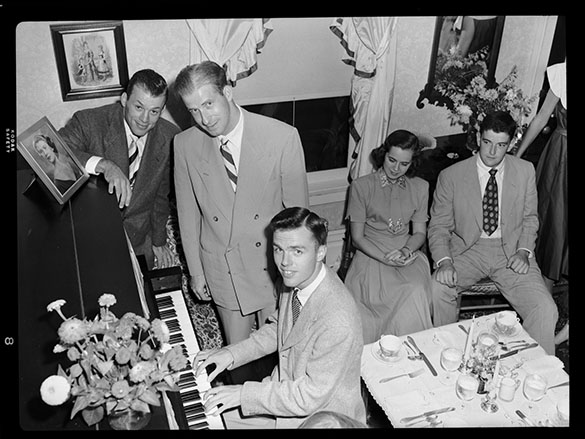
In late spring of 1949, I remember reading in one of the Greensboro newspapers that Chapel Hill publisher Orville Campbell and UNC music student Hank Bebee had written and recorded a song called “All the Way Choo Choo,” a song about my boyhood football hero Charlie Justice. The recording featured a UNC student group, the Sigma Chi Sextet. Campbell also published the sheet music through his publishing company, Colonial Press.
Over the next five months, Campbell and Bebee campaigned the major record labels trying to get the song recorded for greater distribution. In the September 17, 1949 issue of the Greensboro Daily News, Sports Editor Smith Barrier called it “the football song of the season.” Ed Danforth of the Atlanta Journal and Shirley Povich of the Washington Post, during trips to Chapel Hill also commented. Said Danforth: “Greatest college football song since ‘The Ramblin’ Wreck of Georgia Tech,’” and Povich added, “It can’t miss. It’ll go all the way.” Povich added the story in his “Post” column on Sunday, September 18, 1949.
In Greensboro, leading up to WFMY-TV’s official sign-on as North Carolina’s second TV station, which was September 22, 1949, the station presented a special one-hour variety show and the Sigma Chi Sextet group from UNC sang “All the Way Choo Choo.”
UNC student newspaper, The Daily Tar Heel, in its September 22nd edition had this:
Heard the fast-circulating Orville Campbell-Hank Beebe hit “All the Way Choo Choo”? Benny Goodman is definitely scheduled to do a recording of it that should be on sale nationally in approximately two weeks.
Those attending the UNC vs. NC State game in Kenan Stadium on September 24th, 1949 heard the song over the public address system and could also read in their Daily Tar Heel that morning about the Campbell-Goodman progress for the recording:
Orville Campbell, Carrboro publisher turned song-writer received a bit of news a few days back that has made him all smiles. A note penned from an executive of Capitol Records informed the likeable Colonial Press head that Benny Goodman and his orchestra has signed to record “All the Way Choo Choo.” Veteran musicians rate the Campbell-Hank Beebe ditty as a good bet to catch on all over the nation, and the Goodman waxing will make the Carolina Choo Choo one of the first if not the only grid star to be honored in such a manner.”
The next day, the “DTH” added this:
Alumnus Orville Campbell, still a wheel about campus, has been conducting his own promotion campaign, and apparently is enjoying great success in his efforts to make the song “All the Way Choo Choo” popular. Campbell has succeeded to the extent that Benny Goodman has made a recording of it. Also a local version was in evidence at a number of beach juke boxes this summer. The ditty, with music by the talented Hank Beebe, was sung two or three times at this weekend’s pep rally. The song is good, and the more one hears it, the better he likes it.
When the magazine Life ran a cover-story about Justice in the October 3, 1949 issue, the editors included a picture of Orville Campbell’s “All the Way Choo Choo” sheet music. Life captioned the picture “Lyrical Choo Choo.”
Two days later, there was in the October 5, 1949 issue of The Sporting News another article about the song by Smith Barrier with the headline. “All the Way Choo Choo Inspires King of Swing.” Barrier added: “When Benny Goodman, the orchestra leader, heard ‘All the Way Choo Choo,’ he hurried to New York to make a recording.”
Goodman had performed in concert at the ORD Arena (Overseas Replacement Depot, from Basic Training Camp 10 during World War II) in Greensboro on September 16th, 1949 and Orville Campbell was in the audience. Following the show, Campbell played the song for Goodman . . . and Benny liked it.
I haven’t found any evidence that Hugh Morton was at that 1949 Greensboro concert but when Goodman came to Raleigh four years earlier in 1945, Morton was there.

Morton was also on hand when Goodman played in Wilmington on February 23, 1983, and when Benny came back to Greensboro in early May, 1979 to play a concert with the Greensboro Symphony, Hugh Morton was on hand to photograph Goodman back stage and during his performance on May 3, 1979. That Greensboro Concert was recorded by CBS-TV for a special telecast on May 30, 1979 to pay tribute to Goodman on his 70th birthday.
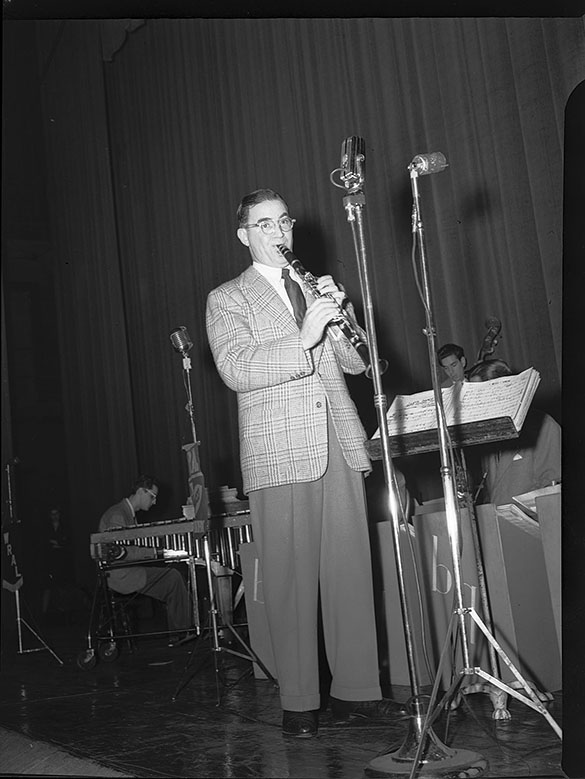
Following Goodman’s 1949 Greensboro performance and the Daily Tar Heel reports, we waited for the news when the Benny Goodman Capitol recording of “All the Way Choo Choo” would be released. The week before the Carolina–Duke game on November 19th came the news that the recording would go on sale on November 23rd . . . but the recording released was a 10-inch King record (15030) by band leader Johnny Long—a Duke alumnus of all things. What happened to the Benny Goodman recording? Don Maynard’s Daily Tar Heel story about the release on November 23rd, said: “The recording would be available at Ab’s Bookstore and the Carolina Sports Shop. Maynard added, “Benny Goodman made the first recording of the tune on a Capitol recording, but to date the number has not been released by the Capitol Recording Company.”
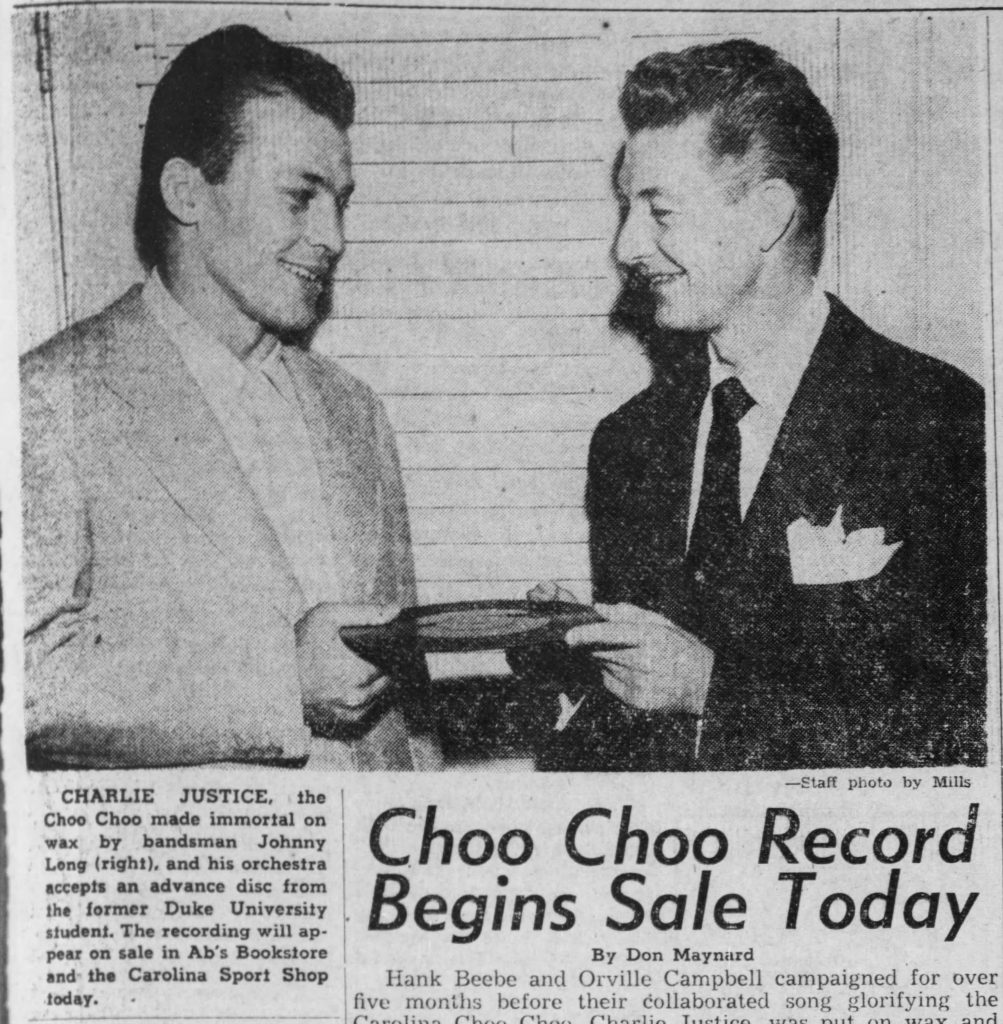
The Maynard article was supported by a photograph of Johnny Long presenting Justice with the first copy of the recording. The picture was taken by student photographer Jim Mills, a Hugh Morton contemporary, and was included with the record purchase. Long had paid a visit to Chapel Hill on November 13, 1949 and made the presentation.
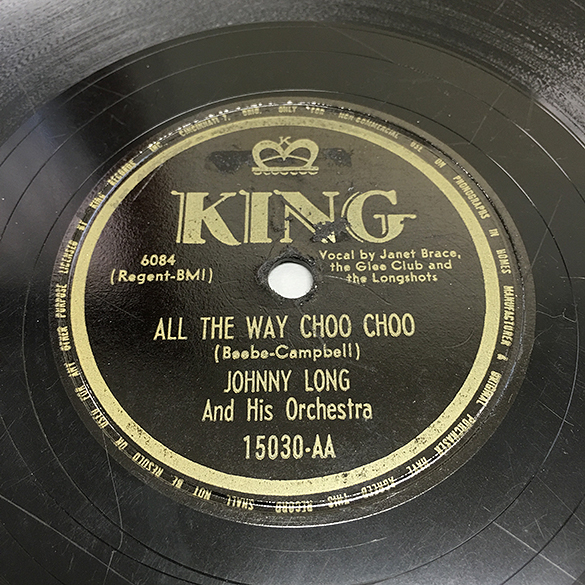
Johnny Long was from Newell, North Carolina and attended Duke from 1931 until 1935. He had played a concert on the Duke campus the weekend of October 28-29, 1949. That’s likely when Campbell played the song for him.
As time went by, we loved and listened to the Johnny Long version, which featured vocals by Janet Brace, the Johnny Long Glee Club and the Longshots. Several of the verses of the song depict actual Justice moments on the gridiron. On the reverse side is an instrumental medley of the “Carolina Victory March,” “Here Comes Carolina,” “Tar Heels on Hand,” and “Hark the Sound.” The Johnny Long record was produced by Johnny Murphy a UNC alumnus from Charlotte and New York City.
On November 26, 1949 when Charlie Justice played his final UNC regular season game against Virginia in Kenan Stadium, the game day program book carried two ads for the Johnny Long version of the song. On page 62 it was described as “the perfect Christmas gift,” and was supported by the Jim Mills photograph. Then on page 71 the record was offered at the Varsity shop. The record sold for one dollar and the sheet music for fifty- cents. According to Orville Campbell, “Justice modestly feels that it is a joke that anyone would want to write a song about him, but at the same time feels honored.”
As years passed, the mystery Goodman version of the song continued to pop up. Bob Quincy and Julian Scheer, in their 1958 Justice biography Choo Choo: The Charlie Justice Story on page 122 put it this way: “Benny Goodman, the famed jazz clarinetist and Johnny Long, a Duke grad who plays a violin from the port side, were among the top recording artists who found ‘All the Way . . .’ worth their time.”
On December 15, 1978, Campbell released a very limited edition album titled, “Thanks for the Memories.” (811054-A 2890) The one-sided album, which has two different front cover designs, contained six of Campbell’s hits, including “All the Way Choo Choo”—both the Sigma Chi and the Johnny Long versions.
The Benny Goodman record mystery lingered. Then in 1979, I read in the Nostalgia Book Club newsletter that a revised edition of a book titled “BG—On the Record: A Bio-Discography of Benny Goodman” by Russell Conner and Warren Hicks had been released. When I got my copy I went through it page by page—all 708 of them—and there was no mention of “All the Way Choo Choo.”
On July 28, 1979, I wrote Conner a letter and asked about the song. His reply on September 4th said, “I have no knowledge of Benny’s playing that tune. But there is a further reference that will become available. The great bulk of the arrangements Benny has used through the years, stored for long time in a warehouse on Broadway, is now being cataloged. . . If the tune was played by the ‘big band,’ the title should crop up.”
Connor was right: when the cataloging had been completed, there it was, listed between “All the Things You Are” and “All Through the Night.”
- File 01/21 “All the Way Choo Choo” 1949
- O’Farrill, Chico
- BG
- No: A203
- Score: Yes
- Parts: none
- Key: A flat
We now know that Goodman performed the tune live in concert. But was a Goodman recording ever released for sale? Some of Goodman’s live concerts were recorded onto electronic transcription discs (ETs) and distributed to radio stations for broadcasts, but I have not been able to determine if “All the Way” was ever distributed in this manner. And of course, there is always that possibility that some black-market recording was made in a venue where Goodman was performing live. There is an interesting observation on the web site “Football Profiles.” In Charlie’s profile, there is this quote:
The hype reached a crescendo for Charlie’s senior season. Orville Campbell, a Chapel Hill music publisher, and Hank Beebe, a graduate student in music, produced a song about Charlie, “All the Way Choo Choo.” The Johnny Long Orchestra recorded it, and the Benny Goodman Orchestra played it on the radio.
Not quite sure how Benny “played it on the radio.” Was it a live broadcast or one of those radio ETs?
The Goodman recording mystery was finally solved in 1995 when Charlie Justice biographer Bob Terrell interviewed Charlie for the book, “All Aboard.” Justice said that Goodman recorded “All the Way Choo Choo,” before Johnny Long did, but the management team at Capitol records thought the tune was too localized for national distribution, so they never released it. (What about that “executive” who sent Orville Campbell that note the “DTH” reported in their story on September 24th, 1949?)
According to Orville Campbell, the tune sold over 32,000 copies.
In 2013 as part of its Carolina First campaign, the UNC Office of University Development issued a compact disc titled “Echoes of Carolina,” and on the disc is the Johnny Long version of “All the Way Choo Choo.”
There are still mentions of the Goodman recording from time to time. An example: The New York Times in its Justice obituary on October 20, 2003 has this line: “Benny Goodman paid tribute in his recording of ‘All the Way Choo Choo.'”
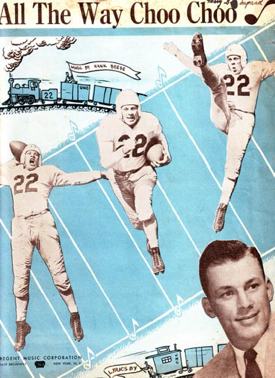
I mentioned that Orville Campbell published the sheet music in 1949. One of the two editions has a Hugh Morton image on the front cover. Recently I found a third version of the sheet music which has a Regent Music Corporation copyright. A quick check of Regent finds that the company was founded in the late 1930s or 1940 at the Brill Building in New York City. Regent founders were Gene Goodman and Harry Goodman—brothers of Benny Goodman. Small world.
Three years before Campbell and Bebee and Long and Goodman started their “All the Way” journey, a writer at The Daily Tar Heel published a Charlie Justice song called “Tiny’s Choo Choo Song.” It was written by Tiny Hutton and published in the November 23, 1946 issue, just hours before Carolina met Duke for the 33rd time. Ironically, the lyrics of Tiny’s tune are set to the music of the 1941 classic “Chattanooga Choo Choo” made famous by Glenn Miller, a contemporary of Benny Goodman. Indeed, a small world.
Sidebars
Over the years, the song title “All the Way Choo Choo” has been used to title other things like two television documentaries, one in 1973 and one in 1984. The ’84 program, produced by David Soloman Productions in Winston-Salem, featured an “All the Way Choo Choo” T-shirt to promote the program.
On March 30, 2006, as part of UNC General Alumni Association’s “College of Lifelong Learning,” the late Dr. Ron Hyatt presented a program titled “All the Way Choo Choo” that featured an extensive Charlie Justice memorabilia display and a panel discussion that included Justice teammates, Walt Pupa, Joe Neikirk, and Bob Cox.
The game program for the 1953 Dixie Classic basketball tournament, which was played in Reynolds Coliseum in Raleigh, carried a full page back cover ad for the Washington Redskins vs. Green Bay Packers preseason game to be played in Raleigh’s Riddick Stadium on September 11, 1954 with the heading “All the Way Choo Choo.”
Five days after Charlie Justice led his Tar Heels into the Cotton Bowl in Dallas, The Daily Tar Heel published a full page Charlie Justice profile with seven pictures under the headline “All The Way Choo Choo: Charlie Justice Makes Last Run.” That January 7, 1950 issue hit the streets just hours before he led the South to victory in the first annual Senior Bowl game, played that year in Jacksonville, Florida.
On October 2, 1949, Rev Dr. Samuel Tilden Habel, Jr. at the Baptist Church of Chapel Hill (Columbia & Franklin) delivered a sermon titled “All the Way Choo Choo.” The headline in the Greensboro Daily News on October 4, 1949: ‘All the Way Choo Choo’ Becomes Sermon Topic. There is a related picture in the 1958 Justice biography by Bob Quincy and Julian Scheer on page 122.
According to author Jackie Helvey at the web site Carrboro.com there was a board game by the same name.
On page 16 of that UNC vs. Virginia game program from 1949, is an advertisement for the Wm. Muirhead Construction Co. in Durham. The ad shows a train approaching a bridge “on Southern Railway and Highway No. 87 & 100 at Glen Raven, NC.” The bridge has a number 22 at the top with the words “All the Way Choo Choo!”
Rollie Massimino (1934–2017)

In today’s news we learned of yesterday’s passing of famed Villanova University basketball coach Rollie Massimino. Above is a detail from a photograph of Massimino made by Hugh Morton on March 17, 1991 during the NCAA East Regional played in the Carrier Dome in Syracuse, NY. A View to Hugh post from 2009 titled UNC vs. Villanova: 1982 and 1985 recounts two Tar Heel encounters against Massimino, and another post, “When Carolina’s Roy Williams and Villanova’s Jay Wright were assistants” includes another Morton photograph of Massimino made during the same game as this photograph.
A final Wallace Wade win in Kenan
When Carolina met Duke on November 25, 1950 in historic Kenan Memorial Stadium, we didn’t know it at the time, but it would be Duke Head Football Coach Wallace Wade’s last coaching appearance against his rival from Chapel Hill. Over a 16 year period from 1934 through 1950, UNC Coach Carl Snavely met Duke Coach Wallace Wade seven times on the gridiron. Snavely won 5 of those games. Wade won in 1935 in Durham and his only win against Snavely in Kenan Stadium came on a cold day in November of 1950.
As official football practice gets underway today for Carolina’s 2017 football season—the 91st in Kenan Stadium, and the 104th meeting with Duke on September 23rd—Morton collection volunteer Jack Hilliard recalls that famous game from 66 seasons ago.

I remember, as a little kid, my dad telling my mom, as he left for work early Saturday morning, November 25, 1950, “I guess Carolina and Duke will play in the snow today.” Had it not been for the covering on Kenan’s turf, my dad would have been right. On Friday the 24th, high winds, snow and bitter 15-degree temperatures moved into North Carolina. The headline in Saturday’s Durham Sun, read: “Vicious Icy Storm Batters East.”
A check of the 1950 UNC football media guide, which was actually published in August, indicated the game was already a sellout. 40,000 of those ticket-holders braved the weather and came out for the game . . . the other 6,000 decided to stay home by the fire and the radio. Photographer Hugh Morton was one of the former.
Head coach Carl Snavely’s North Carolina Tar Heels had beaten head coach Wallace Wade’s Duke Blue Devils the past four seasons and the Heels were made a slight favorite in this, the 37th meeting between the two rival schools. Wade and Snavely had tremendous respect for each other. In July of 1950 the two rival coaches appeared together in the North Carolina outdoor drama “The Lost Colony.” They were special guests as part of Kay Kyser’s and Emma Neal Morrison’s “Celebrity Night” celebrations. Going into the 1950 “battle of the blues,” the darker blue, Blue Devils were 6 and 3 on the season, while the lighter blue Tar Heels were 3-3-2.
As one might guess, wind was to be a factor in the game, so when the Tar Heels won Referee Orrell J. Mitchell’s toss, they elected to defend the west goal with the wind at their backs. The Tar Heels moved the ball inside the Duke 25-yard-line twice in the first half, but couldn’t score. Duke’s only first-half threat came near the end of the second quarter. The Blue Devils went on a 44-yard drive to the Carolina 36-yard-line, mainly through the efforts of Duke captain Billy Cox’s running and passing, but they couldn’t score. The score at halftime was 0-0.
Because of the weather, there was no halftime entertainment on the field. Fans had to be content reading through their game-day programs, which on this day featured a front cover Lon Keller image of radio and TV personality Arthur Godfrey. You could read a column by UNC’s Jake Wade or Duke’s Ted Mann, and get their takes on the game.
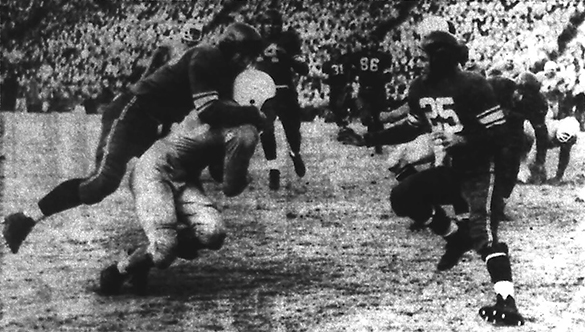
At the 2:58 mark of the third quarter, Coach Wade decided to gamble. Duke with the ball, fourth down at the Carolina 34 and needing seven yards for a first down, tailback Billy Cox took the direct snap from center J. E. Gibson . . . looked down field . . . spotted wingback Tommy Powers . . . and threw a perfect shot which Powers caught as he crossed the goal line. Mike Souchak’s point-after made the score 7-0.
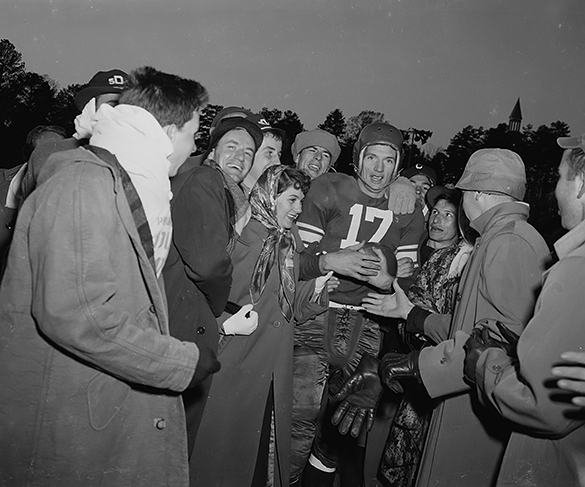
During the final quarter and a half, Carolina had three great opportunities, but the score remained 7-0. The final game stats showed that Carolina had first downs at the Duke 22, 17, 28, 9, 7, and 20, but could not score. In his post game interview, Wade praised Duke’s incredible defense.
As the game ended and the late November sky began to turn a darker shade of gray, the Duke players rushed to hoist their victorious coach on their shoulders; but as we had come to expect, Coach Wade wanted no part of anything like that. Wade told his players, “No, no, boys there’ll be none of that. Let’s go shake their hands.” He then walked calmly across field for a final time and shook Snavely’s hand, just as he had done on six previous occasions when the two coaches had played one another. It would be Wade’s first, final, and only win in Kenan Stadium against a Snavely-coached Tar Heel team.

When the field cleared, the Carolina cheerleaders, led by head man Joe Chambliss, rolled the Victory Bell across the cold Kenan turf to the Duke section on the North side of the stadium, as the Blue Devil fans cheered. It was their first opportunity to ring the bell since its introduction following Carolina’s 1948 win. (That respectful type Victory Bell transition seems to have been forgotten in today’s world of overwrought fan and player hostility.)
The headline in Sunday’s Charlotte Observer, read: “Blue Devils’ Gamble Pays Off for Score in High Wind and Freezing Temperature.” Coach Snavely, when asked in his Monday morning news conference about his impression of Saturday’s game, had this to say: “Duke was hotter than we were in several crucial moments. . . . You must remember that Duke played in the same weather we did.”
Four days after the game, Wade married Virginia Jones and after a honeymoon in New York, he announced his resignation from Duke in order to take the position of Commissioner of the Southern Conference. He would hold that position for ten years. Upon his retirement from the Southern Conference in 1960, words of praise came from media outlets across the country. One of those tributes came from an avid UNC Tar Heel, who broadcast UNC football games on the Tobacco Sports Network…Bill Currie, then the Sports Director of WSOC-TV, Channel 9, in Charlotte once said: “Nobody ever gets over being a Tar Heel. He also said this about Coach Wade:
“The true measure of Wallace Wade’s greatness as a man is not fully reflected in his overwhelming won-lost record on the field, nor in his patriotic devotion to our country in combat during two world wars: rather, it is reflected in the dignity and bearing of the man, which makes him a giant among his peers and successors.”
William Wallace Wade was inducted into the National Football Foundation’s College Football Hall of Fame with the Class of 1955. Twelve years later, in 1967, Duke Stadium was renamed Wallace Wade Stadium in his honor.
He died on October 7, 1986. He was 94-years-old.
Always on call for his alma mater
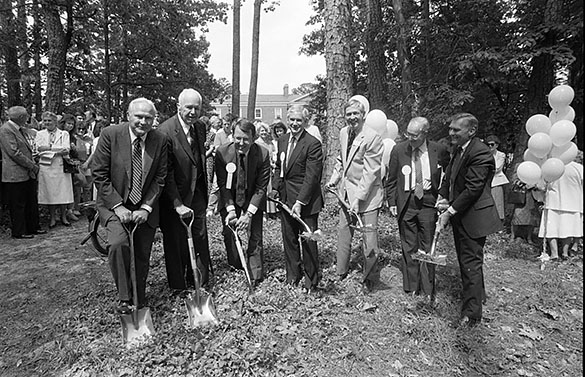
On Tuesday, June 7, 2016—one year ago today—a special memorial service was held at the Old Chapel Hill Cemetery on Raleigh Road. The University of North Carolina at Chapel Hill had lost one of its strongest supporters. Three days before, Ralph Strayhorn Jr. had passed away in Winston-Salem. He was 93-years-old. On this anniversary, Morton Collection volunteer Jack Hilliard looks back at Strayhorn’s amazing list of accomplishments.
Ralph Nichols Strayhorn Jr. at one time or another served his university as
- cocaptain of the varsity football team;
- member of UNC Board of Trustees;
- President of the General Alumni Association;
- General Counsel for the Rams Club;
- chairman of the search committee charged in 1987 with finding a replacement for Head Football Coach Dick Drum (he and his committee found Mack Brown);
- President and General Counsel of the Educational Foundation, Inc.; and
- Fund Raising Chairman for the George Watts Hill Alumni Center building project.
As you will see later in this post, this list will continue.
A native of Durham, Strayhorn was recruited by UNC assistant football coach Jim Tatum and played three seasons with the Tar Heels before he entered the United States Navy and served in the Pacific theater from 1943 until 1946, completing his active service as a sub-chaser commanding officer. He served twenty years in the U. S. Naval Reserve, retiring in 1962 as a lieutenant commander.
He returned to Chapel Hill in time for the 1946 football season where he was a cocaptain along with Chan Highsmith. In a 2010 interview, Strayhorn described his returned: “It was a delightful time to be in Chapel Hill. Everyone was glad to be home from the war, back in school where they belonged.”
The 1946 Tar Heels under Head Coach Carl Snavely won eight games during the regular season while losing only to Tennessee and tying VPI (formally Virginia Polytechnic Institute and State University, known today as Virginia Tech). That record was good enough to earn a Southern Conference championship and Carolina’s first bowl game, the Sugar Bowl on January 1, 1947. Strayhorn’s trip to New Orleans was not a joyous occasion as it should have been. His father had suffered a heart attack back in Durham and was unconscious.
“My mind wasn’t focused on the game, needless to say. I thought about not going. My first cousin was a doctor and was very close to our family. He said my father would want me to go and play in that game. I stayed behind when the team left and then caught the last train to New Orleans. . . I was on the first train back out of town. I returned to my father’s bedside but he never recovered.”
Strayhorn could have played one more season with the Tar Heels. The 1943 season didn’t count against his eligibility because he had gone off to World War II; he chose, however, to graduate with the class of 1947 with a degree in commerce and enter law school. He got his law degree in 1950 and joined the firm of Newsom, Graham, Strayhorn, Hedrick, Murray, Bryson and Kennon as a senior partner. He held that position until 1978 when he assumed the executive position of general counsel of the Wachovia Corporation and the Wachovia Bank and Trust Company. Strayhorn retired from that position in his 1988 retirement. He then joined the law firm Petree Stockton & Robinson.
Throughout his professional career, Ralph Strayhorn remained active in the life of his alma mater, especially its athletic programs and his beloved football Tar Heels. From 1973 until 1981 he was a member of the UNC Board of Trustees, serving as chairman in 1979 and 1980. Additionally, he served on the Central Selection Committee of the Morehead Foundation, the Board of Visitors, and the NC Institute of Medicine. In 1989 the UNC Board of Trustees awarded Strayhorn the William Richardson Davie Award.
Over the years, Strayhorn kept in touch with Coach Jim Tatum and in 1955 he wrote Tatum a four-page letter asking him to return to Chapel Hill to take over the football program. “The football situation at Chapel Hill seems to have reached an all-time low,” Strayhorn wrote. The following year Tatum returned and led the program until his untimely death in July of 1959. Ironically, in 1957 Strayhorn had prepared Tatum’s will and delivered the document to him the week before the Tar Heel were to meet Maryland for the first time since Tatum left—the famous “Queen Elizabeth” game. As the coach was signing the document, he asked Strayhorn if he was going to the game on Saturday.
“I told him I didn’t have tickets, transportation, a room or a baby-sitter. He said, ‘Well, find yourself a baby-sitter. I’ll take care of the rest. You be at the airport Friday at 2 o’clock.’ We got to the airport and everything was arranged for us.”
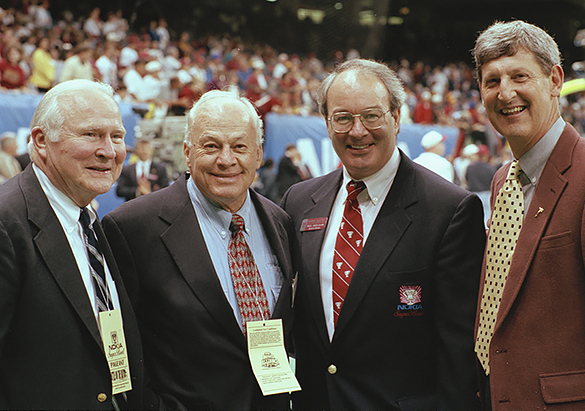
In December 1996 Carolina’s 1947 football team celebrated the 50th anniversary of their ’47 Sugar Bowl game with a train trip to New Orleans for the 1997 Sugar Bowl game. An on-the-field pre-game ceremony included Charlie Justice and Ralph Strayhorn along with Charlie Trippi of Georgia. Hugh Morton was a special invited guest at the ceremony.

Seven years later, on November 5, 2004, Ralph Strayhorn and Hugh Morton were featured speakers at the dedication of Johnpaul Harris’ magnificent Charlie Justice statue which now stands just outside of Kenan Stadium.
The next time you visit the “Charlie Justice Hall of Honor” in the Kenan Football Center, notice the Harold Styers’ portrait of the 1947 Sugar Bowl coin toss featuring UNC’s Cocaptain Ralph Stayhorn #62, and Georgia’s Captain Charlie Trippi, also #62.
And oh yes . . . that list. Ralph Strayhorn Jr. was President of the North Carolina Bar Association in 1971-72, and a member of the
- Legal Advisory Committee of the New York Stock Exchange;
- American College of Trial Lawyers;
- American Bar Association;
- International Association of Defense Counsel;
- Newcomen Society of the United States; and the
- Board of Visitors of the Wake Forest School of Law.
He also argued a case before the Supreme Court of the United States and served in the North Carolina General Assembly in 1959.
Ralph Nichols Strayhorn Jr., a Tar Heel treasure like no other.
UPDATE: caption for second photograph revised to reflect identification received in a comment on June 12. Previously the caption began with “THREE TAR HEELS.”
UPDATE: On June 13, the caption was once again update with the discovery of more recent information about Charlie Carr. Mr. Carr was a member of the UNC Class of 1968 and he received a master’s degree from there in 1970. In 1971 he became a UNC assistant football coach. He also served in various roles at East Carolina, Mississippi State before joining Florida State in 1995. Carr left Florida State on October 1, 2007, when he became the athletic director at Midwestern State University in Wichita Falls, Texas. On May 17, 2017 Mr. Carr entered phased retirement from MSU, and he will officially retire on August 31. Also updated was the caption for the final photograph with the identification of Bill Hartman, the Georgia Bulldog’s team captain in 1937. (Thanks, Jack Hilliard, for new info on Charlie Carr and the identification of Bill Hartman!)
Back at the track
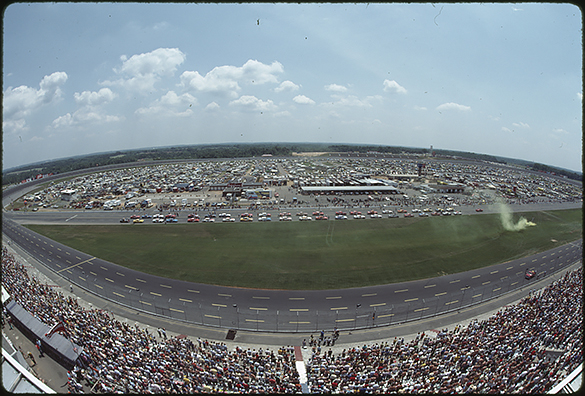
NASCAR’s longest race of the season, the Coca-Cola 600, will be run at the Charlotte Motor Speedway on Sunday, May 28, 2017. This year’s event will mark the 58th running of the race that started back in 1960 when it was called the World 600. That name continued until the 1985 race when Coca-Cola became a major sponsor.
In 1978 NASCAR held a supporting race, a Late Model Sportsman Series 100-mile race the day before the 600 miler. The following year NASCAR held the Sun Drop 300, and beginning in 1980 the Mello Yello 300. In 1982 the 300-mile race became part of the Busch Series, with another sponsorship name change to the Winston 300 in 1985. Today the race is called the Hitense 4K TV 300.
Back on May 7, 2010, Jack Hilliard wrote a post about the North Carolina Sports Hall of Fame, and Hugh Morton’s wife Julia added this comment: “I remember how anxious Hugh was to have Stock Car Racing ‘declared a sport.’” Four years later, Jack wrote a post about the 1971 National 500 at Charlotte’s famous mile-and-a-half oval. He wrote in the article that while High Morton is famous for his sports photography, there aren’t many NASCAR events represented in his portfolio.
Fast forward to earlier this year, when Jack noted in the Morton collection finding aid the following entry:
- Slide Lot 008864: “World 600, Viaduct,” (NASCAR), June 1983 #P0081, Subseries: “Other events, 1940s-early 2000s”
With the 2017 Coca-Cola 600 approaching, Jack wrote an article looking back thirty-four years to the then World 600 of May 29, 1983. This morning, as I was assembling the image scans and writing captions for the World 600 posting, all was well . . .
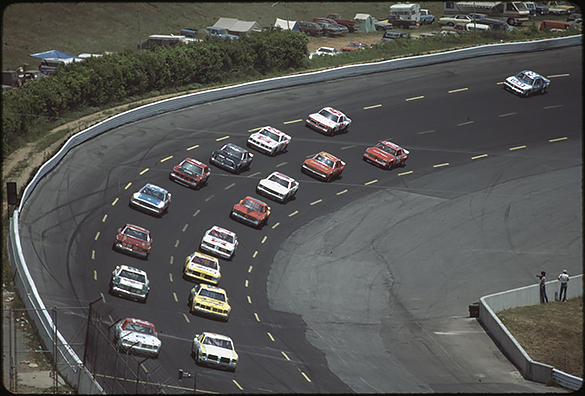
I dropped in another image . . .

. . . and moved on to the next.
In the World 600, Hueytown, Alabama’s Neil Bonnett edged out Richard Petty by 0.8 seconds for the victory. Could this image be the two dueling as they came out of the last turn? Alas, no because the car is yellow and Jack’s article had a quote by Bonnett from after the race:
Richard was dictating how fast I had to run. I knew I had to pick up the pace because every time I looked in my rear view mirror I saw that red-and-blue car and I knew that man meant business.
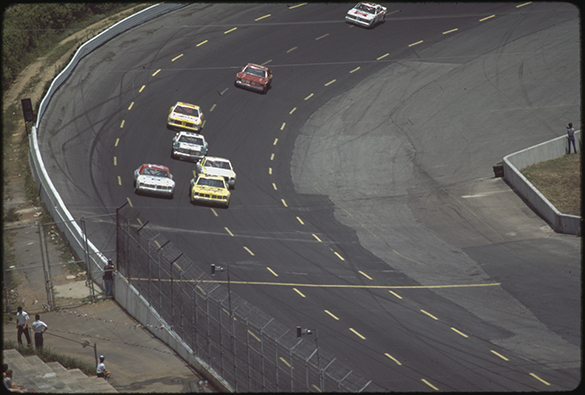

Then I placed the following photograph, Morton’s slide #19, and something was awry . . .

The above photograph, Morton’s 35mm color slide #19, depicts a pack of cars exiting turn four with car 23 in front of cars 34, 76, and 5. To write a caption, I looked up on the Internet and found the race results with a list of the drivers’ names and car numbers. That’s when I discovered that none of those car numbers raced in the World 600. Digging a bit more, I learned about the Mello Yello 300 and found a list of drivers and car numbers for that race, then emailed the news and webpage links to Jack. He found footage of the entire race on YouTube, and by comparing the beginning minutes of the film footage to Morton’s wide angle photograph shown at the top of this post, we confirmed that Morton’s photographs are of the Mello Yello 300 and not the World 600. The race broadcaster mentions (at 4:20 on the video), “Dale Earnhardt in the Wrangler car, number 15.” As the results webpage shows, Dale Earnhardt defeated Neil Bonnett to win the Mello Yello 300.
There’s still a little “Morton Mystery” left, though: some of the car numbers seen in slide 19 are unknown. According to the list on the website Ultimate Racing History, the driver for car number 23 was Davey Allison while Joe Kelly drove the following car, number 34. The next car, 76, is not listed . . . nor is car 47. In between those two cars is car 5 driven by John Anderson. Dale Jarrett is next in car 32, followed by Slick Johnson in car 46. With two car numbers unaccounted for, is it possible that Hugh Morton attended the qualifying race the day before? That’s not likely because car number 7 in the second photograph above is probably pole sitter Morgan Shephard. Or, more likely, is the list of drivers on the Internet list incomplete or contain some errors?
That’s what I could piece together this morning before today’s 1:00 starting time. Any race fans out there who can add more to the story?
Addendum: May 28, 2017
Jack found a website, Racing-Reference.info, with the results of the 1983 Mello Yello 300 that include cars 76 and 47 driven, respectively, by Butch Lindley and Randy Tissot.
Another “Morton Mystery” (that we didn’t know we had) has been solved!
THE Voice of the Tar Heels
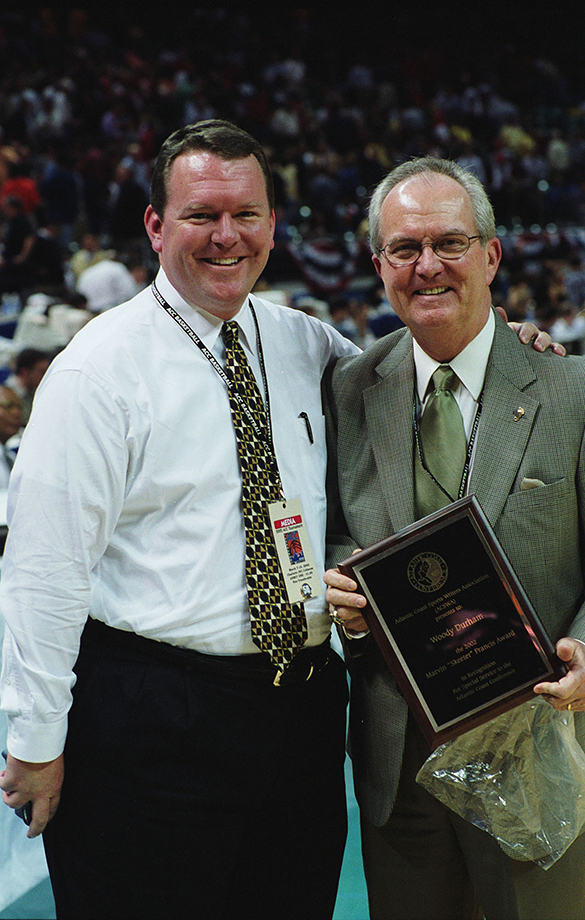
Today, April 22, 2017, Carolina’s Woody Durham will receive the Lindsey Nelson Broadcasting Award at the University of Tennessee Orange and White spring football game in Knoxville. This will be just the latest in a long line of awards that fill his trophy case. Woody’s son Wes will be on hand to accept the award for his dad. On this special day, Morton volunteer contributor, Jack Hilliard, reminisces about his long-time friend and UNC classmate.
Many of the recent reports in the media of Woody Durham’s health issues have described him as “The Voice of the Tar Heels for 40 Years.” While that is true, there is far more to it than that. Woody Durham was, is, and forever will be The Voice of the North Carolina Tar Heels, period. Others will broadcast the play-by-play of the Tar Heel games and will do it well, but none will ever come close to what Woody Durham was able to accomplish . . . the bar is just too high.
I came to work for WFMY-TV in Greensboro on February 6, 1963 and worked until July 24th, when I left for a short tour of active duty with the US Army. When I returned in January, 1964, WFMY’s long-time sports director Charlie Harville had left for the new station in High Point and taking his place was Woody Durham, a classmate from UNC. While at Carolina, I had often watched Woody and news anchors Ray Williams and Dave Wegerek from the WUNC-TV control room in Swain Hall as director Wayne Upchurch directed the evening news. I decided then that I wanted to direct a show like that someday. But I never imagined that my path would cross with Woody’s and Dave’s down the road.

When I returned to WFMY in ’64, I got a promotion from the floor crew to a control room job—audio and technical director, then assistant director. And in early November of 1966, I got to direct my first newscast and for me it was magical. As had been the case back at WUNC-TV, Dave Wegerek anchored the news and Woody Durham anchored the sports. I had the honor and privilege of working with Dave for four years, and with Woody for almost fourteen, until August of 1977. During that time with Woody, I saw a master at work. From a ten-second promotional announcement to a one-hour documentary it was always the same: carefully research, then script it and deliver it with dignity, class, and style. That’s the way Woody has lived his life, with perhaps a bit less emphasis on the scripting part. And that’s the way he’s approaching his current health struggles.
As most of the Tar Heel Nation will recall, Woody delivered a letter to his many friends and fans on June 1, 2016. In it he explained his current health condition with primary progressive aphasia, a neurocognitive disorder that affects language expression:
I can still enjoy the company of friends and traveling with my wife, Jean, but I am not able to address groups as I did in the past,” Durham said. “While learning of this diagnosis was a bit of a shock for Jean and me, and yes, quite an ironic one at that, it also brought a sense of relief to us in terms of understanding what was happening to me and how best to deal with it.
Goodness knows, Tar Heel fans have heard him often over the years telling the Tar Heel story for the Athletic Department, the General Alumni Association, the Tar Heel Sports Network, and you name it, Woody has been there. And as you would likely guess, Woody is using his health issue to help people become aware of aphasia and how it affects individuals and families.
As in the past, I will continue to attend Carolina functions and sporting events as my schedule permits, and be part of civic and other charitable endeavors throughout the state. As part of these events, we want to make people more aware of primary progressive aphasia, and the impact that these neurocognitive disorders can have on individuals, families and friends.
Along with raising awareness, we hope to encourage financial support for continued research and treatment in our state, as well as nationally.
Over the years, Woody has urged us to “go where you go, and do what you do” when a close game was on the line. As Woody’s friend for more than 50 years, I would urge all to take Woody’s game advice because he is involved in yet another difficult struggle. And in the end, when he wins this battle, (and I choose to believe he will), he can say, as he often has said following a big Tar Heel victory: “Act like you’ve been there before.”

I think it’s appropriate that we update Woody’s progress on the web site which is everything Hugh Morton. Woody was a Hugh Morton photo subject often and during the 2005-2006 UNC basketball season, Woody gave us periodic reports on Hugh’s condition.
On October 5, 2013, there was a very special event at the Turchin Center on the campus of Appalachian State University in Boone. I was honored to be a panelist along with Betty McCain, Robert Anthony, and Woody Durham. Our topic: “Hugh Morton and His Photography.” It was a magical afternoon . . . one to forever remember.
So on this special day I say: “Best wishes, dear friend, our thoughts and prayers are with you, Jean, and family.”
Morton photographs of Augusta National
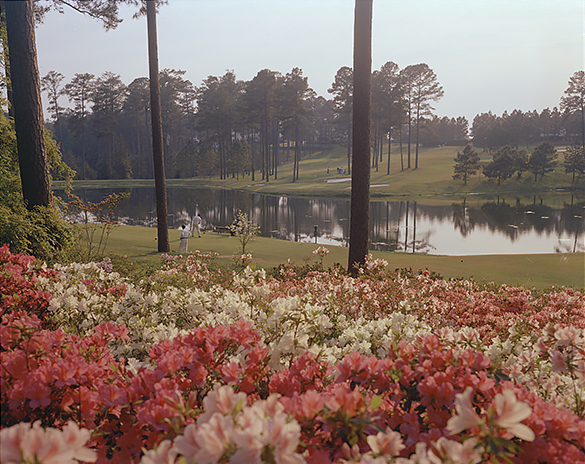 Yesterday while looking through Sheet Film Box P081/C-24 in the Hugh Morton collection, I came across the above color negative labeled “Augusta Nat’l for John Wms.” Today, coincidentally, is the opening round of the Masters Tournament, so I had the negative digitized for posting on A View to Hugh. Turning to the finding aid to see what additional material on Augusta National might be in the collection, I found the following:
Yesterday while looking through Sheet Film Box P081/C-24 in the Hugh Morton collection, I came across the above color negative labeled “Augusta Nat’l for John Wms.” Today, coincidentally, is the opening round of the Masters Tournament, so I had the negative digitized for posting on A View to Hugh. Turning to the finding aid to see what additional material on Augusta National might be in the collection, I found the following:
Roll Film Box P081/35C-6
- Envelope 6.4-6-1, “Golf, Augusta,” 1971, Color 35mm roll film negatives, 35 images
Roll Film Box P081/120C-5
- Envelope 6.4-4-1, “Augusta” (mostly scenic golf course), 1971?, Color 120 roll film negatives, 31 images
- Envelope 6.4-4-10A, “Augusta National for John Williams” (golf course), 1970s-early 1980s, Color 120 roll film negatives, 6 images
Some of the images depict a foursome and others playing the course; many other negatives are scenic views. The images didn’t seem to merit scanning them all just to select a few to use for the blog, but if anyone is ever looking for images of the Augusta National circa 1971 (the 35mm negatives are labeled Spring 1971 but the reaming dates are estimates), you may aways request to see them or have them digitized. One of the negatives, however, depicted a gentleman sitting outside a door with the nameplate “John H. Williams.”

So two question remained: Who is John Williams and what is his connection to Hugh Morton? According to his obituary from May 2013, Williams “was recognized nationally as one of the great financial minds and deal-makers in America during the 1960s and 1970s.” The portrait of Williams in his obituary looks very much like the man pictured above, so it’s safe to say this is photograph of Williams at Augusta National.
Based in Tulsa, Oklahoma, Williams was co-founder, president, and chief executive officer of The Williams Companies from 1949 to 1971, and chairman and CEO from 1971 to 1979. When he retired, the company’s assets were $2 billion. Listed among his many accomplishments and associations: Williams served on the board of Augusta National Golf Club . . . and “Grandfather Golf and Country Club and Linville Golf Club of Linville, NC.” At the time of his death, Williams and his wife resided in both Tulsa and Linville. And therein lies his connection to Hugh Morton. Turning back to the Morton collection finding aid, there are thirty-one entries for John Williams spanning the 1960s through the 1980s.
That’s what I discovered after a little investigation. Please leave a comment if you would like to add to the story.
